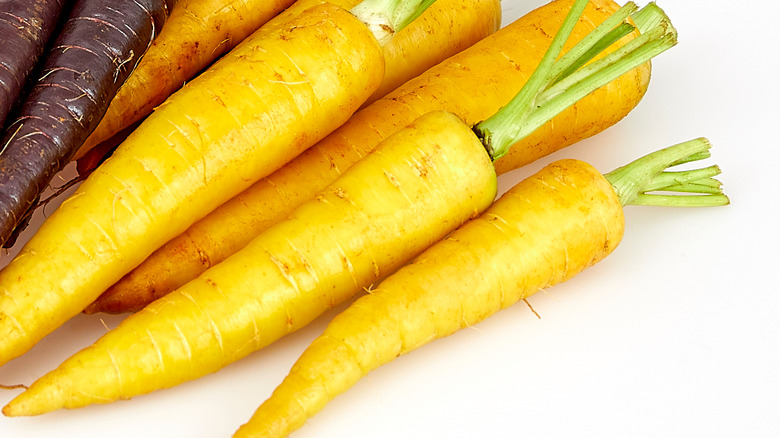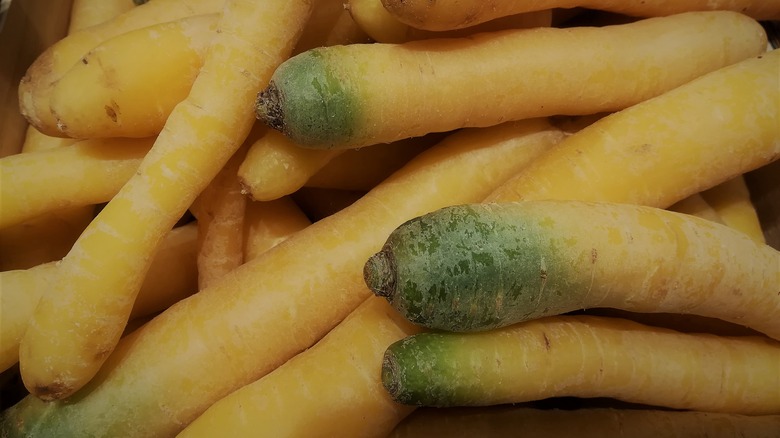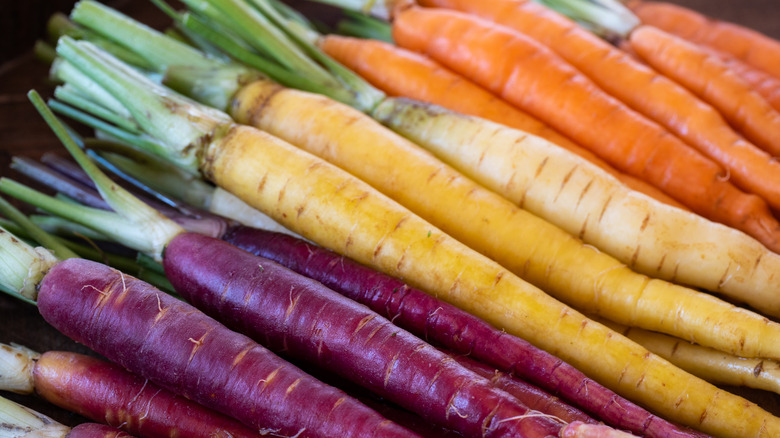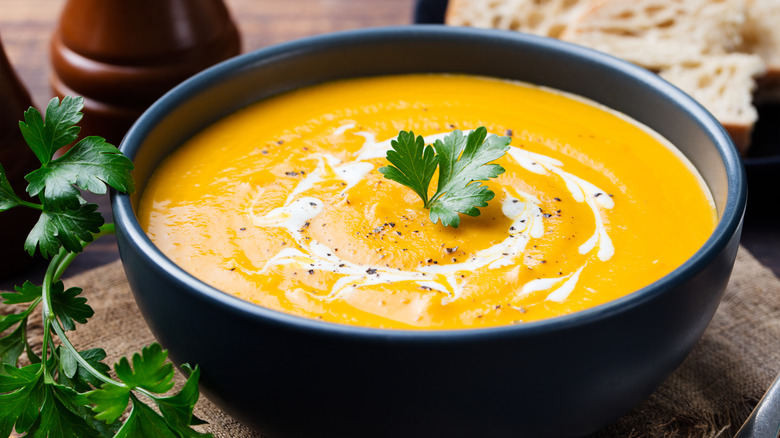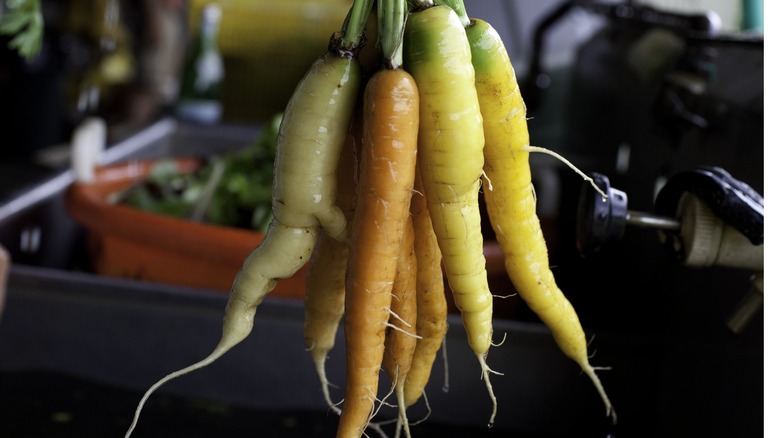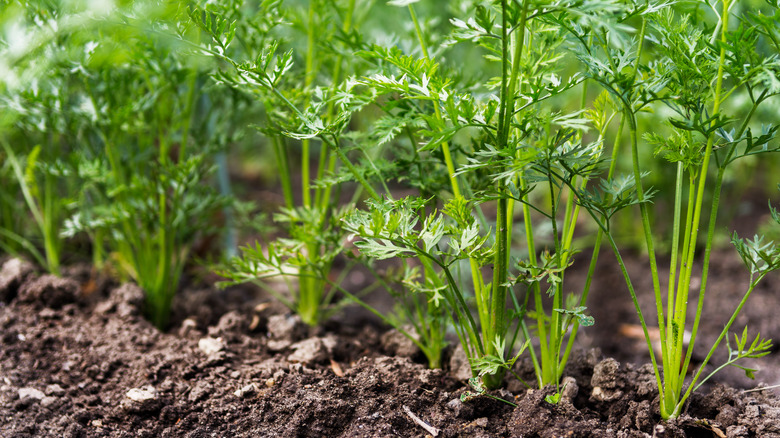What Are Yellow Carrots And What Do They Taste Like?
We may receive a commission on purchases made from links.
When you think of the carrot, scientific name Daucus carota (via: Britannica) and cultivated widely on every continent on the planet save for Antarctica, you almost certainly picture a bright orange root vegetable, and in most cases, that's what you'll find when you look for carrots at the grocery store or farmer's market. But as it happens, orange is but one color of carrots, and it is the most common not for any reason of inherent value or superiority over other varieties, but in fact for political reasons dating back some 400 years.
According to The Washington Post, "for centuries, almost all carrots were yellow, white, or purple [but] in the 17th century, Dutch growers cultivated orange carrots as a tribute to William of Orange [who had] led the struggle for Dutch independence." The color remained popular in the Netherlands and soon gained popularity far and wide. Which is notable because for the first few thousand years during which human beings were eating carrots, orange carrots were a less common variety. While wild carrots were consumed since prehistoric times, evidence of carrot domestication can be traced back to Central Asia to around 1000 CE , according to Britannica, and by the Medieval period they were commonly grown in China and in much of Europe.
Carrots came to the so-called New World with Europeans colonists in the 16th century, and before long they were a part of cuisines all around the globe.
What do yellow carrots taste like?
According to Specialty Produce: "Yellow carrots are Nantes type varieties, having both round shoulders and a blunt non-tapered tip (there are at least three known types of carrots: Imperator, Danvers, and Nantes) [and] they have a firm and crunchy texture." They are yellow all throughout, though often with a pale green tinge near the top of the carrot and with the green coloring running partway down the tapered sides.
In terms of taste, provided the carrots have been allowed to grow to full maturity, they "have been described as tasting earthy, with notes of celery and parsley" (via: Carrot Museum).
Yellow carrots are often sweeter than orange carrots, especially when picked while still smaller and more tender. Eaten raw, according to Cook's Country, "they have a fruity aftertaste that is devoid of bitterness. Cooked, this carrot ... tastes earthy sweet, like a sweet potato." Both raw or cooked, yellow carrots can be used in place of orange carrots in many dishes and recipes.
The health benefits of yellow carrots
All carrots are healthy. In fact, according to Healthline: "The carrot ... is often claimed to be the perfect health food." They are low calorie, very low fat, high in fiber, and packed with vitamins, minerals, and antioxidants. But while all carrots have great health benefits, different varieties offer differing advantages as far as your health and wellness is concerned.
Yellow carrots are particularly high in "the carotenoid lutein, a pigment similar to beta-carotene that is absorbed as Vitamin A in the body," according to Specialty Produce. Lutein offers you several specific healthy benefits. According to Carrot Museum: "Lutein help[s] develop healthy eyes [and] aids in the fight against macular degeneration and may prevent lung and other cancers and reduce the risk of atherosclerosis (hardening of the arteries)."
For reference, purple carrots are very high in beta carotene content (like orange carrots) and are rich antioxidants that protect cells components by fighting harmful free radicals, red carrots are high in lycopene (as are tomatoes) which helps prevent macular degeneration and can stave off heart disease and prostate cancer, and black carrots, which are highly perishable thus rare, are very high in antioxidants thanks to their abundance of phenolic compounds (via: Carrot Museum).
Cooking with yellow carrots
As noted, yellow carrots can be used as a stand-in for "regular" orange carrots in myriad recipes, but they do lend themselves to particular dishes with extra grace. Yellow carrots make for a delicious soup, especially when cooked along with ingredients like leeks or ginger that balance out the natural sweetness of the carrot (via: Ricardo Cuisine). They are delicious roasted or pan fried, boiled and sliced or pureed, and they can of course be enjoyed raw in salads, slaws, or as carrot sticks, though the cost may be a factor if you are hoping to use them for a crudités platter.
Also, according to Specialty Produce: "Yellow carrots boost the nutritional value of soups, stews, salads, and are an indispensable ingredient in stocks." So taste and health benefits are at hand.
Where to buy yellow carrots
Finding yellow carrots can be a good deal more of a challenge than finding orange carrots, especially if you want only yellow carrots, not a blend of colors. If you are trying them primarily for interest, go ahead and buy a bunch of so-called rainbow carrots that includes yellow carrots in with purple, orange, white, and other varieties, as rainbow carrots are usually easier to find. Either way, look in the organic section of your grocery store or, better yet, shop at an entirely organic supermarket.
You should also always try the fresh produce stands at local farmer's markets. You have a good chance of finding yellow (or at least rainbow) carrots at farmer's markets because local vendors don't have to worry as much about bulk sales where larger, more common orange carrots usually tend to win out. You can find yellow carrots for sale from some online grocers, or you can order seeds online (or buy them from a local gardening shop) and grow your own yellow carrots.
How to grow yellow carrots
Growing your own yellow carrots from seed is not difficult provided you can create the right conditions for them to grow. The ambient daytime temperature should ideally not reach above 80 degrees, with around 55 degrees at night being ideal. You want a bed or large planter that's at least 12 inches deep, and if you want to plant multiple groupings of seeds, these groups should be planted at least one foot apart from one another (via Gardening Know How). The soil should be on the looser side, so take the time to turn and till it with a pitchfork or trowel, and stir in some compost or fresh organic soil to give your carrots the nutrients they need to thrive.
Place three or four carrot seeds in a shallow hole sunk a bit less than an inch down into the earth and then loosely cover them with soil. Now simply keep the carrots watered enough for the soil to stay moist. Within two to three weeks, the carrots should have green leaves sticking up about four or five inches above the soil. At this point, you should gently pick and replant most of the little carrots, spreading them so that each has at least two or three inches of space on all sides.
Now keep watering the soil to moistness for a few more weeks, and when you can see the thick yellow "shoulders" of your carrots emerging from the soil, they are ready to be picked and enjoyed.
